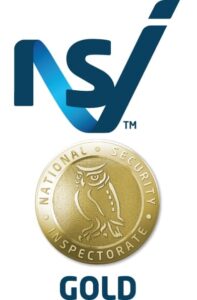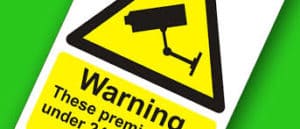The 12 guiding principles
-
- Use of a surveillance camera system must always be for a specified purpose which is in pursuit of a legitimate aim and necessary to meet an identified pressing need.
- The use of a surveillance camera system must take into account its effect on individuals and their privacy, with regular reviews to ensure its use remains justified.
- There must be as much transparency in the use of a surveillance camera system as possible, including a published contact point for access to information and complaints.
Proper signage is necessary to comply with the Guiding Principles
- There must be clear responsibility and accountability for all surveillance camera system activities including images and information collected, held and used.
- Clear rules, policies and procedures must be in place before a surveillance camera system is used, and these must be communicated to all who need to comply with them.
- No more images and information should be stored than that which is strictly required for the stated purpose of a surveillance camera system, and such images and information should be deleted once their purposes have been discharged.
- Access to retained images and information should be restricted and there must be clearly defined rules on who can gain access and for what purpose such access is granted; the disclosure of images and information should only take place when it is necessary for such a purpose or for law enforcement purposes.
- Surveillance camera system operators should consider any approved operational, technical and competency standards relevant to a system and its purpose and work to meet and maintain those standards.
- Surveillance camera system images and information should be subject to appropriate security measures to safeguard against unauthorised access and use.
- There should be effective review and audit mechanisms to ensure legal requirements, policies and standards are complied with in practice, and regular reports should be published.
- When the use of a surveillance camera system is in pursuit of a legitimate aim, and there is a pressing need for its use, it should then be used in the most effective way to support public safety and law enforcement with the aim of processing images and information of evidential value.
- Any information used to support a surveillance camera system which compares against a reference database for matching purposes should be accurate and kept up to date.
Aiming to Protect and Support Individuals and Communities
The Surveillance Camera Code of Practice, originally published in 2013, provides a set of 12 Guiding Principles for organisations looking to use CCTV to ensure they do not cross over from providing protection and support for individuals and communities to being seen as breaching their human rights, particularly their right to privacy.
The code is binding on “relevant authorities” which includes law enforcement authorities, such as the police and local authorities. It is then hoped that other organisations wishing to operate CCTV systems will voluntarily comply with the 12 guiding principles.
Surveillance Camera Commissioner Role Created
The role of the Surveillance Camera Commissioner was created at the same time under the Protection of Freedoms Act 2012. The role of the Commissioner, Tony Porter, is to encourage – but not to enforce – compliance with the surveillance camera code of practice. He has produced a useful publication to assist organisations understand if they comply with the principles.
Guiding principles 1-4 address the development or use of surveillance camera systems. To comply you need to be able to answer the question what is the CCTV system for and do you review its use.
You need to have signage to make it clear that surveillance is taking place and this should have a published point of contact if they have any queries or complaints. There should also be a clear line of responsibility for the CCTV system and staff need to understand their responsibilities. Organisations also need to have carried out a privacy impact assessment that is published to ensure that people’s right to privacy is not infringed.
Principles on the use of images and information
Principles 5-12 address the use or processing of images and information. To comply there needs to be clear rules, policies and procedures for the CCTV system and staff need to know and understand them. In particular, there needs to be a policy for the storage of images and for the disclosure of information. Images should be held securely and stored no longer than they are needed. There is a presumption that the criminal justice system should also be able to use your system to support its work if required.
In addition, if you use specialist technology such as facial recognition or automatic number plate recognition you need to have a policy to ensure that the information contained on your database is accurate and up to date.
Going forward you need to consider if your surveillance system is still required and whether there could be an alternative solution to the system.
Ecl-ips is a well-established CCTV provider. We are committed to adhering to best practice in respect of CCTV installation and our recent NSI Gold status approval confirms our determination to achieve the highest standards that we can reach. If we can help you develop a CCTV system contact us.



